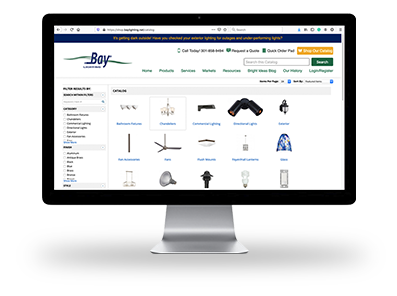Blog
- Home
- Resources
- Bright Ideas Blog
- The Metrics that Matter
The Metrics that Matter
By Pete Messman
It is increasingly difficult to argue against having energy-efficient lighting installed in a parking garage. Even garages that were built recently with traditional metal halide or high-pressure sodium fixtures should be considering a retrofit as the benefits affect everyone—customers, managers, and owners. But there is a huge variety of choices, each with certain trade-offs. Understanding how to make an apples-to-apples comparison can be difficult. That is why it is important to understand the metrics that matter.
Let’s begin our discussion by reviewing some of the key terminology used in lighting. A lumen (lm) quantifies the illumination that is emitted from a fixture. In the U.S., the measurement of the light in an area is referred to as a footcandle (fc). Watts are the amount of energy a fixture draws to produce its illumination. And it’s a lamp, not a bulb, that produces illumination. Illumination is what you want. Watt-hours—or more commonly kilowatt-hours (kWh)—are what you pay for.
Retrofit Considerations
When choosing to undergo a lighting retrofit, there are a few common issues that are prioritized differently for each buyer:
The safety of drivers and pedestrians is an obvious reason to start, as insufficient light levels that fail to meet Illuminating Engineering Society of North America (IESNA) standards jeopardize everyone and put building owners at significant liability risk. Unfortunately, most garages today do not meet the standards for absolute minimum illumination on a surface (1 fc), average on pavement (6 fc), and maximum-minimum uniformity of light throughout the garage (10:1). Even people who have no idea how to use a light meter know when a dark garage doesn’t feel safe.
Cost is another huge factor. Short lamp life and high labor costs are driving maintenance through the roof for many operators. And the electricity required for metal halide and high-pressure sodium fixtures is twice what it takes to get the same illumination with newer applications.
Sustainability is another area of significant focus in the parking industry, whether for new facilities or retrofitting existing structures. Fortunately, energy-efficient lighting retrofits are one of the low-hanging fruit green investments that offer excellent paybacks. Depending on local electricity rates and incentives that may be available, these projects routinely have project paybacks of two years or less. Additionally, until the end of 2013, a federal tax deduction was available under the Energy Policy Act of 2005 (EPAct) for commercial properties. While this deduction has expired, there is an effort on Capitol Hill to have it reinstated. Given the federal corporate tax rate of up to 35 percent, this tax deduction can provide a significant boost when evaluating these projects.
Once customer safety and satisfaction are recognized, along with the economic benefits, where’s the best place to start? Unfortunately, too often, decision-makers who are unaware start with technology. Whatever is the flavor of the day gets first consideration. If it’s the newest, it must be the best, right? But in reality, buyers will pay a premium for any technology that is still going up the product development maturation curve. Early adopters simply get less overall value for their money.
Additionally, there may be an exclusive focus on electricity consumption, resulting in inadequate light levels. As an example, a 175W MH fixture consuming 215 watts and providing light that just meets IESNA standards is putting out approximately 11,500 lumens after a year burn-in. Replace that with a 47W LED fixture that is putting out roughly 3,900 lumens after the same period of time. What is the result? A 75 percent reduction in electricity costs, which sounds great. But that goes along with a 66 percent reduction in light output, which is most likely going to make a bad lighting situation dramatically worse.
So, what are the metrics that really matter? And by metrics, we’re referring to quantifiable data that are readily available and provide the basis for a reasonable comparison. Decisions should be driven by what creates the safest, most appealing parking environment while providing the best financial performance. Taking the decision-making process to a more fundamental level, however, the key outcomes that owners and operators want are good light, cheaply, and for the long haul. Thus, the three primary metrics that matter in decision-
making are:
- Luminous efficacy, or lumen output per watt consumed.
- Cost effectiveness, or lumens of output per dollar spent.
- Total lighting value, including electricity and maintenance savings over the life of the system.
The Metrics
Start with good light. Meeting the IESNA standards is a minimum. To ensure those light levels, it’s critical to evaluate how much light a new fixture will provide for the amount of electricity it will consume. This is luminous efficacy. Fortunately, as a metric, it transcends technologies, which is what makes it so important. All that is required is a basic calculation: lumen output divided by watts consumed. What we see looking at stated performance specs for parking garage lighting is that LED efficacy ranges between 70 and 100 lumens per watt (lm/w). Induction lights are around 70. And fluorescents are around 95 to 110. These values are compared to metal halides, which are around 50 lm/w. As you can see, newer technologies are still playing catch-up to older ones.
Too often, garage lighting is considered only from the cost perspective. But having an appreciation for the benefits of a well-lighted environment doesn’t mean money is no object. Far from it—even decision makers who believe in the importance of good lighting want to make sure they are getting the most bang for their buck. That’s why the next metric is cost-effectiveness. Using efficacy and dividing it by the installed cost, we’re able to get a good picture of the value that each fixture provides to deliver a lumen. In general, for fluorescent fixtures, it costs just less than $2 per lm/w. For induction, the cost is around $6. And LEDs cost between $9 and $11, or as much as five times the cost of a fluorescent fixture that delivers the same amount of illumination.
Garage lighting projects don’t happen very often. Lights are installed when a garage is built and then they can (and should) last 15 to 20 years or more. All will need some level of maintenance, whether it’s new lamps, lenses, or ballasts, or a power-washing or other cleaning to get rid of bird nests. Wires start to age, drivers fail, or connections come loose. And while paybacks on lighting retrofits are usually in the two- to four-year timeframe depending on conditions, the continued return on investment comes over the long haul, when energy savings and reduction of maintenance costs from longer lamp life come into play.
Long-Term Value
When evaluating long-term paybacks, the easiest metric to understand is total cost per hour. While it’s one thing to calculate savings based on electricity consumption, incorporating operations cost from maintenance is trickier as different lamp life, variation in the cost of lamps, and serviceability all factor in to this critical cost. Take the installed cost of the fixture, plus the total energy costs over an evaluation term and add in the relamp and reballast or fixture replacement costs over that period. By dividing that cost by the total number of hours over the term, we are able to see how much it actually costs to illuminate a space from each fixture. In this case, we find that over the long term, LEDs are more than twice as expensive (2.8 to 3.3 cents per hour) as the least cost option, which are fluorescents at 1.4 cents per hour.
Total cost per hour implies equivalent light output, which is very much not accurate. Garage lights depreciate (or outright fail) at very different rates. This is why total lighting value (TLV) is so significant and the third key metric. When calculating TLV, it is important to use initial light output, rates of depreciation, and rated life to try to get a reasonable estimate of the average illumination. By incorporating the lighting performance with the cost factors and then comparing those against one another, it is possible to get a reasonable comparison of total lighting value across technologies. It is the entire life-cycle cost integrated with the lighting performance over the long-term.
Note that the LED and Induction fixtures are generally what is known as “nonserviceable,” meaning that rather than putting in a new lamp or ballast as required, once the fixture no longer produces adequate light, the entire unit must be replaced.
In nonserviceable fixtures, such as nearly all LEDs, the elephant in the room is that once the fixture goes dark, it’s done—there is no inexpensive relamping option available. So while the theoretical rated fixture life may be 10 years or more, it’s important to note the way this is calculated. For most fixtures, rated life is based on an estimation of when 50 percent of the fixtures will still perform satisfactorily, which is generally recognized as 70 percent of original output (L70). Therefore, 50 percent of the fixtures will not perform satisfactorily at that time. Whether this is caused by the LEDs burning out, internal wiring coming loose, or a driver failing, as a nonserviceable fixture it’s rip-and-replace or let the garage light levels plummet. For other fixtures in which relamping and reballasting are options, fixtures can last decades and continue to generate positive economic returns long after the initial retrofit project has been performed.
While the metrics outlined here are the most critical, there are other important factors in a lighting retrofit decision that can be somewhat more difficult to quantify. These include the reliability of the manufacturing and the ability of the fixture to withstand the harsh environmental stress of a parking garage. Many new technologies are being developed both by traditional players with already-established track records and by startups that do not have a reputation to rely on. For example, the U.S. Department of Energy’s LED Luminaire Reliability study noted that nearly 20 percent of their tested fixtures did not even reach 1,000 hours before dropping below L70.
Lighting performance is another factor that often gets overlooked. There are a couple of key aspects that help drive how lights actually look once installed. The first is an uplight contribution that will illuminate the entire cavity of the garage and reduce the cave effect that can make a garage look dark and foreboding. Uniformity, where illumination is consistent throughout the parking and drive areas, eliminates the “checkerboard” effect that can be so distracting to drivers. The color of the illumination and the glare produced by a fixture can also have significant impact on how a retrofit will look.
When evaluating potential options for a relighting project, recognize the key metrics for evaluating options across all technologies and choose wisely.





